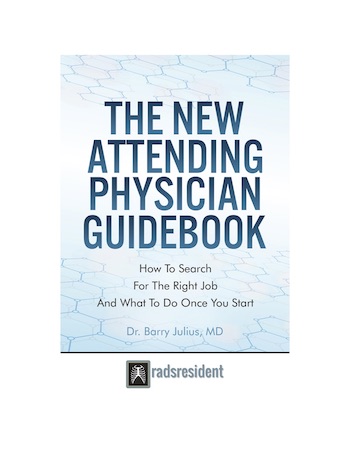Many of you have probably heard about the classic acronym for choosing a lifestyle specialty called ROAD: Radiology, Ophthalmology, Anesthesiology, and Dermatology. But does radiology still belong in this acronym? Or should we entirely discard this as an ancient historical quirk? (Those days fifty years ago when we only used X-ray, nuclear medicine, and ultrasound!) So, let’s look at the criteria that should make up a lifestyle specialty, including the amount of time that you need to work, the amount of money that you can make, the amount of stress in your daily work life, and the flexibility of living and working where you want when you want. Then, let’s go through whether we, as radiology specialists, can still meet the criteria for a lifestyle specialty and compare it to others. And finally, let’s give the radiology specialty a final grade.
Grading Criterion For Radiology As A Lifestyle Specialty
Hours
This first criterion is a bit hard to pin down. Why? Because it all depends on how much time you want to put into your career. I know folks who want to care for their children, work three or four days a week, and never take a weekend call. (Of course, you pay for that!) Then, others want to spend lots of extra time to be the breadwinner for the family. But, if you take the average radiologist and the average week, most are on the job more than they would like to admit. We can have long days that can easily breach ten or eleven hours if the work becomes busy. Yet, not all days are like that. So, the average radiologist works a nine-hour shift five days a week.
However, we have a little more vacation than most other specialties. And part of that is a historical quirk. Back in the day, around the beginning of the twentieth century, many radiologists became sick from radiation sickness’s harmful effects. Therefore, they tended to have more vacation time to compensate. Flash forward to today, and you will still find radiologists with a bit more vacation than most (even though our jobs do not expose radiologists to as much radiation).
Unfortunately, that time may not be during the holidays and summer weeks because hospitals need our services twenty-four hours a day, seven days a week. And some poor radiologist needs to cover! To average it all out, if I had to give a grade to this criteria, I would call it a B-. The extra vacation would boost our report card as opposed to other specialties. But, I am dinging us for the constant need for radiologists to work. If you had to compare our hours to other medical areas, others would work shorter and easier days with less vacation time. So, I certainly could not give us an A. But, yet we don’t have constant patient care like some internal medicine and surgical docs. B- minus seems reasonable to me!
Money
Money is a much easier criterion to define because we can base that number on a per-hour basis. And we can always harken back to our favorite medical specialty salary survey at Medscape. It’s a quick and dirty way to compare the average specialist’s salary for most medical specialties. The 2020 Medscape survey quoted the average radiology salary as the fifth most highly paid specialty out of twenty-nine at 427,000 dollars annually. So, that is in the top 20th percentile. For that reason, I can easily substantiate the grade of an A-. We are certainly not paid as much as the majority of Orthopedics and Neurosurgeons. But, indeed, we are nowhere near the salary of most pediatricians!
Stress
Ahh. This criterion is also highly variable, depending on your subspecialty. Some folks are purely outpatient and work in very cush environments or at home. And other folks are bombarded continuously with ER cases and stat procedures like neuro-interventionalists. However, as a whole, we typically don’t have to perseverate on phones with insurance companies like other subspecialties (I consider that one of the most significant stressors!) Yet, all of us are getting tons of phone calls. Moreover, we can enact actual harm to patients because what we say matters significantly to patient care, including life and death (a cause for aggravation and lawsuits!).
So, let’s compare it to other specialties. Dermatologists don’t have as many life-and-death decisions. Yet, ob/gynecologists, surgeons, and internal medicine docs have much more aggravations with insurance companies and uncompliant patients. So, I will give our specialty a B-, a standard average grade.
Flexibility
Now, if I had to pick one area where we excel, it is flexibility. We can live where we want, work when we want, be academic or private, and see patients or not see patients as we wish. I can’t think of any other specialties with our far-reaching flexibility for types of work as a radiologist. We can live and work in the country or the city. You can work on the weekends only or during the nights or days. Or, we can rarely see a patient again (especially as a teleradiologist!)
In this department, we beat out pretty much all the specialties. Not one even comes close to radiology when it comes to flexibility! I would have to give this criterion an A+.
Is Radiology A Lifestyle Specialty: The Final Conclusion
So, let’s give all our grades a weighted average and pretend we are still in college. Here is a post with the conversion info!
Hours: B- or 2.7
Money: A- or 3.7
Stress: B- or 2.7
Flexibility: A+ or 4.0
Drum roll, please. If you average out our grades based on these criteria, you get a final grade of 3.275, just a little shy of a B+. But let’s call it a B+, for argument’s sake. Do you think that still makes a lifestyle specialty? I think so. But, perhaps, not as much as you might have thought at first! It’s not an A!
Want to learn more about the specialty of radiology and the training involved? Check out my book on Amazon. And click on the link below. (I am an affiliate of Amazon as well!)











